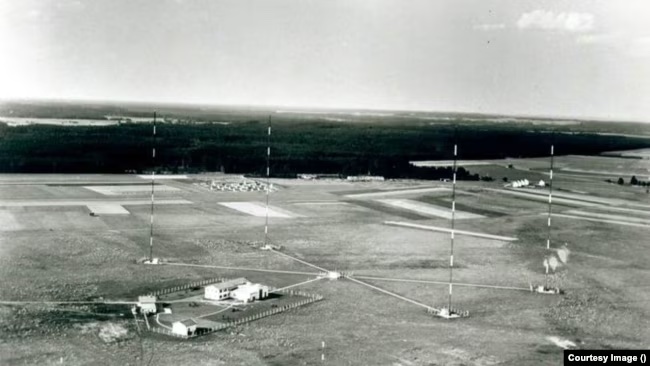Holzkirchen: RFE’s First Medium Wave ‘Voice of Freedom’
May 1, 2021 marked the 70th anniversary of Radio Free Europe’s (RFE) first medium wave broadcast, from Munich, Germany to Czechoslovakia.

May 1, 2021 marked the 70th anniversary of Radio Free Europe’s (RFE) first medium wave broadcast, from Munich, Germany to Czechoslovakia. On that same day in 1951, RFE celebrated two other major milestones: the first transmission from a studio in RFE’s unfinished Englischer Garten studio complex, and the first direct-to-listener broadcast from RFE’s new medium wave (AM for the U.S. audience) transmitter base at Holzkirchen, south of Munich.
On the site of a former WW II Luftwaffe base outside of town, back-dropped to the south by the mighty German Alps, a 135,000 watt transmitter had been erected to transmit The Voice of Free Czechoslovakia in the medium wave band. Carola, as she was known, was multiple times more powerful than any comparable transmitter in the United States. Even with directional antennas that concentrated her signal, Carola had the ambitious task of reaching Czechoslovakian homes, which were more than three times further away than Austrian ones.
By 1953, Eagle, located closer to the Czechoslovakian border near Cham, Germany, would join Carola in the medium wave band. Eagle’s role was short lived as she only transmitted a 50,000 watt signal, had no directional antenna system, and interfered with Armed Forces Network (AFN) transmissions. These issues, and extensive flooding in 1954, sealed Eagle’s fate and she was decommissioned. Later, she would resurface at Swan Island and be used during the Cuban Bay of Pigs invasion.
A dedication ceremony was held on May 1 at Munich’s Bayerische Hof Hotel for the new transmitter. Author and former RFE/RL Security Director Richard Cummings makes note of the event in his Cold War Radio Vignettes blog. The ceremony brought together many officials, members of the Czechoslovak expatriate community and high-ranking officers of Radio Free Europe and its parent organization, the National Committee for a Free Europe.
This plaque would later be mounted on the Holzkirchen transmitter building and remain there until ownership of the site was transferred to the International Broadcasting Bureau (IBB) in 1995; at which time it went into storage.
Holzkirchen would go forward to be a relay station sending programs to the RARET transmitters based in Portugal. From there, the programs would be rebroadcast to their target countries on shortwave. The first of these featured a reprise of Barbara’s role in the first experimental shortwave transmission on 4 July 1950, again to Czechoslovakia, on 4 July 1951. Barbara had taken a road trip from Lampertheim, Germany, to Gloria, Portugal, in order to do this. She would have “simulcast” with the shortwave transmitters that had been installed at Biblis, Germany to take over her role months earlier. Barbara would operate “solo” for six months until eight higher powered transmitters would be completed.
Holzkirchen would continue its medium wave transmission for decades with Carola being replaced in 1967 with a 150,000 watt Continental transmitter. As a sign of the times, the naming of transmitters had ended. Additional shortwave transmitters were installed along with a “curtain” antenna system. This antenna system would create a signal “beam” towards its target country and was so strong the airspace in front of it was a recommended “no fly zone”.
Unfortunately, a couple of pilots inadvertently penetrated this space and suffered the consequences. The highest profile case occurred in 1984, when a British-built West German Tornado jet fighter lost flight control and slammed into the ground, instantly killing the pilot and navigator. It is suspected that an incorrectly connected cable shield had allowed the shortwave signals to penetrate and affect the aircraft’s control systems.
The antenna system was not always a purveyor of destruction, though. Sometimes it was the target of Mother Nature’s wrath. In the wintertime, lower Bavaria was susceptible to ice storms. And many times, the weight of the accumulated ice would bring the towers crashing down. This means of “silencing” the transmissions was much more effective than any Soviet jamming; and less expensive as well.
Holzkirchen would continue its relay duties through the late 1980s until a satellite distribution system directly from Englischer Garten made that role obsolete. This would eventually also make obsolete the relay receiving station, Maxoqueira, in Portugal — which then found a new life as a transmitter site.
The relay transmitters would be decommissioned in 1990. And the final decommissioning of Holzkirchen, in 2004, would see the antenna fields dismantled and the transmitters repurposed at other U.S. Government transmission sites.
Holzkirchen is no longer in the fight against Communism and Tyranny. It now challenges a new set of adversaries; the site has been transformed into a golf course.
Golf, the only game where the contestant plays against oneself. And after 50 years of service, one might say it’s a good way to enjoy retirement. A fitting testament to all the men and women that made Holzkirchen successful on May Day 1951.